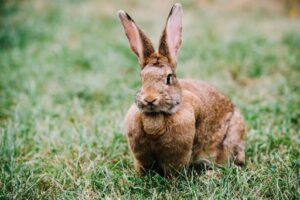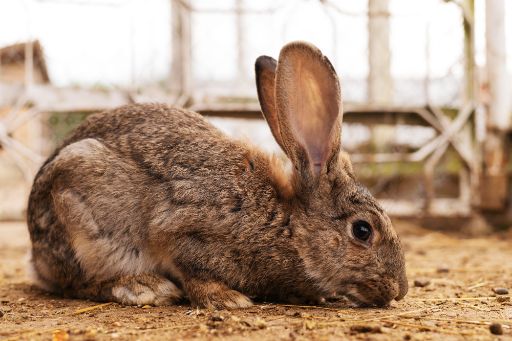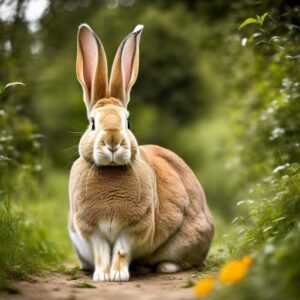Unveiling the Gentle Giant: The Fascinating World of Giant Flemish Rabbits
Introduction
The Giant Flemish Rabbit is a member of the animal world that may not be as well-known as the stately lion or the elegant dolphin, but it is as compelling in its own special way. These gentle giants have won the hearts of animal lovers all across the world by enthralling people of all ages with their remarkable stature and lovable dispositions. We’ll explore the huge Flemish rabbit’s habitat in this post, learning about their history, traits, maintenance needs, and why they make great pets.

The Giant Flemish Rabbit’s Origins
Flemish Giants are a very old farmed rabbit breed. The breed, which was originally farmed for meat and fur, existed in Belgium by the 16th century. The first breed criteria were published in 1893.
Despite being a domesticated breed, Flemish Giants maintain certain wild rabbit traits. They have enormous ears that contribute to strong hearing as well as superb eyesight, which would aid in detecting predators.
Understanding Their Color Variations
The colours of giant Flemish rabbits range from sandy to black, blue, and fawn. Each coat colour gives these gentle giants a distinct flair, enabling potential owners to select their favourite.
The Gigantic Dimensions
Giant Flemish rabbits are mainly notable for their large size, which must be mentioned when talking about them. These bunnies are renowned for growing to proportions that astound onlookers. One of the largest farmed rabbit breeds in the world, an adult may weigh as much as 13 to 14 pounds (5.9 to 6.4 kilogrammes) or even more.
The Gentle Giant’s Personality
Giant Flemish rabbits are famous for their kind and friendly attitude, which truly sets them apart from other species. Due to their well-known placid demeanour, these bunnies make wonderful pets for both people and families. They have a reputation for enjoying petting and may develop close relationships with their owners.
How long do Flemish Giant rabbits live?
The lifetime of Flemish Giant rabbits is renowned for being rather lengthy. They may live for **8 to 10 years if given the right care and frequent veterinarian appointments. This is comparable to several smaller breeds of rabbits. Although they are mostly healthy animals, they might experience a few health problems.
How can I take care of a Flemish Giant rabbit?
Although owning a big Flemish rabbit might be gratifying, there are certain duties involved. The following information can help you protect your animal friend’s health;
1. Requirements for housing
These rabbits require roomy housing due to their size. To provide them adequate space to move around and extend their legs, a sizable hutch or playpen is necessary.
2.Food and Nutrition
Your big Flemish rabbit’s health depends on receiving the right nutrients. High-quality hay, fresh produce, and specially made rabbit pellets should make up the majority of their diet.
3. Play and exercise
Giant Flemish rabbits, like other rabbits, benefit from routine exercise. For their wellbeing, give them space to wander in a safe, bunny-proofed location.
4. Haircare
Their thick fur needs regular trimming to stay in good shape. By brushing their coat, you can lower the likelihood of mating and hairballs.

Why Choose a Giant Flemish Rabbit as a Pet?
A Friendly Family Supporter
These gentle giants are a great option for families with kids because of their reputation for tolerance and patience.
Outstanding Litter Training
Giant Flemish rabbits are low-maintenance pets in terms of hygiene since they are simple to litter train.
Unusual and captivating
They are conversation starters only by virtue of their size, and their endearing personalities only serve to increase their attractiveness.
Conclusion
The Giant Flemish Rabbit is unique among pet rabbits not just for its size but also for its mild temperament and appropriateness as a pet. These adorable giants have a certain charm that has won the hearts of many, and because of their reasonable care needs, they are a fantastic choice for both inexperienced and seasoned rabbit owners.
FAQs (Frequently Asked Questions)
Can I feed my rabbit pellets as the main diet?
Pellets are not recommended for a complete pellet-based diet for rabbits. Instead, they should be fed mainly grass-based hay, which should make up about 80% of their daily food intake. A healthy rabbit diet should consist of at least one bundle of good quality hay daily, an adult-sized handful of
leafy green vegetables, and a small amount of pellets or nuggets daily. Fresh, clean water should be available at all times. Muesli-style foods are not recommended for rabbits. To transition to a healthier diet, gradually reduce pellets and increase hay and leafy greens. Consult a veterinarian for specific dietary recommendations.
What are some suitable vegetables for Flemish Giant rabbits?
Flemish Giant rabbits require a balanced diet consisting of leafy green vegetables like cabbage, spinach, lettuce, carrots, broccoli, and celery. These vegetables are rich in vitamins, minerals, and iron. It’s important to introduce new foods gradually and monitor your rabbit’s response to ensure they tolerate them well. Wash all vegetables thoroughly before feeding them. Consult a veterinarian or a rabbit care guide for specific dietary recommendations based on your rabbit’s individual needs.
What are some common health problems in rabbits?
Rabbits are susceptible to various health issues, including digestive system problems, respiratory infections, skin disorders, dental disease, and uterine problems. Hairballs and intestinal infections can cause blockages and complications, while respiratory infections can cause sneezing, coughing, and difficulty breathing. Skin disorders can result from infections, parasites, and pododermatitis, while dental issues due to continuously growing teeth can cause pain and difficulty eating. Uterine problems can occur, and spaying female rabbits at an appropriate age can help prevent these issues. Regular veterinary check-ups, a balanced diet, proper hygiene, and a safe living environment are essential for maintaining rabbit health and well-being.
What should I do if my rabbit stops eating?
If your rabbit stops eating, it may indicate a serious health issue and requires immediate attention. To diagnose and treat this, follow these steps: observe your rabbit closely, check their environment, offer tempting foods, and contact a veterinarian if their appetite doesn’t improve within 12 hours or they appear quieter than usual. It’s crucial to seek professional veterinary advice to assess your rabbit’s condition and recommend appropriate treatment. Rabbits that don’t eat for even a day are in a life-threatening situation and require immediate veterinary attention.




